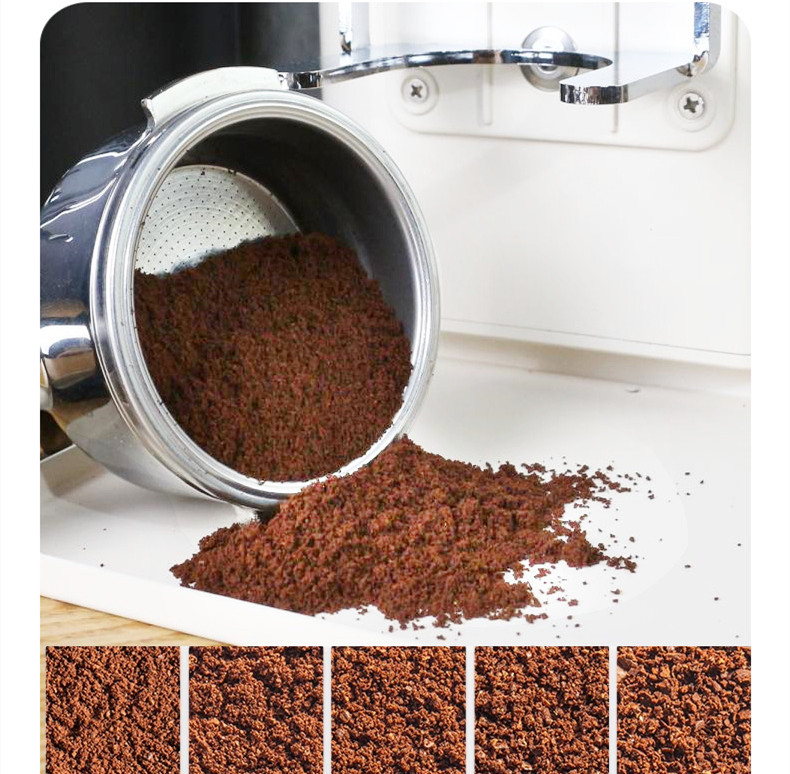Preliminary preparation
Coffee bean selection and grinding
Freshness: Prioritize freshly roasted coffee beans as they can retain more aroma and flavor substances. Generally speaking, coffee beans that have been roasted within two weeks are of better quality.
Grinding degree: According to the pressure and extraction requirements of the semi-automatic espresso machine, the coffee beans are ground into particle sizes similar to fine granulated sugar. If the grinding is too fine, the water flow will be blocked when passing through the coffee powder, resulting in an excessively long extraction time and the coffee may be too bitter. If the grinding is too coarse, water will flow through quickly, resulting in insufficient extraction. The coffee will be overly sour and have a thin taste.
Cleaning and preheating
Cleaning: Ensure that the handle, filter screen, brewing head and other components of the coffee machine are clean and free of residue. Residual coffee grounds and oil can affect the flavor of the next extraction and may also cause machine malfunctions. The handle and filter screen can be rinsed with clean water, and the cooking head can be wiped with a clean cloth.
Preheating: Turn on the power of the coffee machine and let it preheat for a period of time to allow the boiler and brewing head to reach the appropriate working temperature. The preheating time is usually around 15 to 30 minutes, but the specific time varies depending on the machine model. Insufficient preheating will affect the extraction effect, resulting in insufficient coffee temperature and poor flavor.
Powder filling and powder pressing
Filling the coffee powder: Pour the ground coffee powder into the filter screen on the handle, and gently shake the handle to evenly distribute the coffee powder. The amount of powder to be filled should be moderate. Generally, it is determined based on the capacity of the handle and one’s own taste preference. The common amount of powder to be filled is between 14 and 18 grams.
Pressing the coffee grounds: Use a powder press to compact the coffee grounds evenly and moderately. The purpose of pressing the powder is to make the coffee powder compact and flat, ensuring that water flows evenly through. If the powder is pressed too lightly, the coffee powder cake will be loose, the water flow will be uneven easily, and the extraction will not be sufficient. Excessive powder pressing makes it difficult for water to pass through and the extraction time is too long. After grinding, the surface of the coffee powder cake should be smooth and flat, without obvious cracks or depressions.
Extraction operation
Install the handle: Attach the handle containing the coffee powder to the brewing head of the coffee machine. Make sure it is securely installed and not loose. When installing, pay attention to aligning the handle with the cooking head to avoid leakage.
Start extraction: Press the extraction button to begin extracting espresso. During the extraction process, observe the flow rate and color of the coffee. Under normal circumstances, the extraction time should be around 25 to 30 seconds. The coffee liquid that flows out should be dark brown and have a fine layer of oil (crema) on the surface. If the extraction time is too short, the coffee may be too sour and have a weak taste. If the extraction time is too long, the coffee will be too bitter and have a burnt taste.
Control the amount of coffee extracted: Adjust the amount of coffee extracted according to personal taste and the size of the coffee cup. Generally speaking, the extraction volume of a single espresso is about 30 milliliters, and that of a double espresso is about 60 milliliters.
Milk foam making (when making milk coffee)
Choose milk: Whole milk has a higher fat content. When whipped, the milk foam is finer and denser, making it suitable for making milk coffee such as lattes and cappuccinos. You can also choose low-fat milk or skimmed milk according to your personal taste, but the quality of the milk foam may be affected to some extent.
Preheating and cleaning of steam rods: Before using the steam rod, turn on the steam switch first to allow the steam rod to discharge some condensate water, which also serves the purpose of preheating. Then wipe the surface of the steam rod with a clean damp cloth to remove any remaining milk and dirt.
Whipping the milk foam: Pour the milk into the milk tank. Do not exceed two-thirds of the tank’s capacity to prevent it from overflowing during whipping. Insert the steam rod into the milk to a depth of about one-third to one-half of the milk tank. Turn on the steam switch to make the steam rod spray steam. At the same time, slowly move the milk tank up and down to ensure that the milk is fully in contact with the steam. During the whipping process, it is important to control the temperature of the milk well. Generally, a temperature between 60 and 65 degrees Celsius is appropriate. If the temperature is too high, it will destroy the nutritional components and taste of the milk. When the volume of the milk expands to 1.5 to 2 times its original size and fine, smooth milk bubbles form on the surface, turn off the steam switch.
Blending and latte art: Pour the whipped milk foam into the extracted espresso and blend it first to ensure a thorough mix of the milk foam and coffee. Then you can do latte art according to your own skills and create various beautiful patterns.
Cleaning and Maintenance
Immediate cleaning: After extraction is completed, immediately rinse the handle and filter screen with clean water to remove any remaining coffee grounds. Wipe the brewing head with a clean cloth to prevent coffee stains from remaining. If you have made milk coffee, you should promptly wipe the steam stick with a damp cloth and drain the remaining milk inside to prevent the milk from spoiling and clogging the steam stick.
Regular deep cleaning: Regularly perform a deep cleaning of the coffee machine, including cleaning the boiler, pipes, filter screens and other components. You can use a dedicated coffee machine cleaner and follow the instructions in the manual. The frequency of deep cleaning can be determined based on the usage frequency. Generally, it is recommended to do it once every 1 to 2 months.


